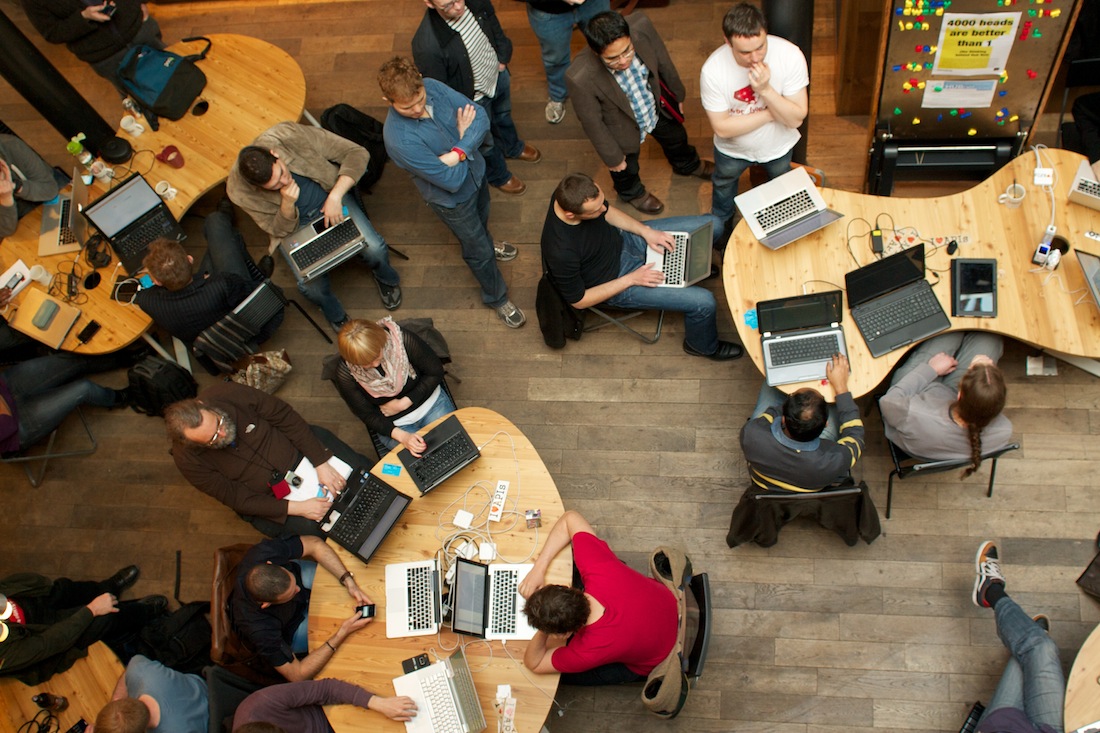Research Xackathon
Upcoming:
Past
- 2024, Research Xackathon in Chicago, USA
- 2024, Research Xackathon in Chiang Rai, Thailand
- 2023, Research Xackathon in Boston, USA
- 2023, Research Xackathon in Lublin, Poland
- 2022, Research Xackathon in Miami/Seattle, USA
- 2021, Online Research Xackathon, July 10-25
- 2019, Research Xackathon at the University of Calgary, Canada
- 2019, Research Xackathon at the Odense, Denmark
- 2018, Research Xachathon at the University of Wisconsin at LaCrosse, USA
- 2018, Research Xachathon at the University of North Carolina at Greensboro, USA
- 2018, Research Xachathon at the University of Macerata, Italy
- 2017, Research Xachathon Pilot at the Johnson & Wales University, Miami, USA
- Report after testing three different Research Xackahon formats in 2018
Main Idea
We go to conferences to develop and advance our research. However, most of the time, we just run run from a session to a session. Maybe get a few insightful comments after our presentation, if we’re lucky. Meet hundreds of people, yet don’t get to talk to anyone for more than a few minutes. Come home with a stack of business cards and can’t even remember who did what presentation.
A research hackathon is similar to a conference in duration and cost, but it yields much better research outcomes. Here is why.
Most researchers mistakenly think that it takes at least a year to develop a good publishable research paper.
No. It takes about a 100 hours to develop a good publishable research paper.
The problem is that we never can find those 100 hours and thus we put in a couple hours here and there, and a year or more comes by from when we had the idea until when we have a finished paper.
At a research hackathon, we lock ourselves in a conference room at a quiet university campus, phones off, laptops on, and do nothing but research for several days.
Stat with brainstorming paper ideas, then on to research design, simple data analysis, results, draft. Every few hours present what you have, get feedback from peers, go work some more, present, get feedback, repeat.
Same time commitment and cost as a conference, but you go home with:
- A very clearly defined paper idea
- A polished study design
- Initial set of results
- Initial draft of the paper
- Most importantly, new friends/co-authors – after a few days of sharing meals, research ideas, and fun, you’ll feel like you’ve known these people forever.
Background
X-Culture is collecting huge amounts of data.
We are tracking over 2,000 variables: longitudinal, multi-level, multi-source, multi-method. Just about anything related to international teams and virtual collaboration – we measure it.
We have dozens of papers in development based on the data, but there are definitely many more good publications hidden in our database.
The problem is that even though over 500 IB professors have participated in X-Culture and most of them are interested in research, we never have time to talk about research. When we meet at conferences, we run from a presentation to presentation and don’t have time to sit down and talk about new research papers.
The 2016 AIB-SE conference was on a cruise ship. That experience was different. About a dozen X-Culture professors attended the meeting and we got to know each other much better and we spent much more time talking about research than usual. We had breakfast, lunch, and dinner together. We had a day off on Cozumel and spent time together visiting ancient Mayan ruins, played golf, took a boat tour to see crocodiles, attended performances, and had lively discussions about work and life.
In those few days, we had gotten to know each other more than in the previous few years of seeing each other at conferences. Most importantly, we brought home lots of interesting research ideas.
That is when we thought why not to take it to the next level and organize a research marathons before major conferences (like AIB) that most of us attend anyway. We tried three different formats in 2018 and all three were found to be very effective, albeit in different ways.
We call it the X-Culture Research Xackathon.
Plan for 2019: Invite journal editors
The Research Xackathon, step-by-step
- X-Culture collects tons of data.
- Researchers interested in international HR/OB come to the research xackathon and
- Intensively brainstorm ideas for papers based on the data,
- Get feedback on the ideas,
- Select the most promising ones,
- Present and critique them,
- Debate research designs and share suggestions,
- Form co-author teams,
- Run preliminary tests,
- Present preliminary results and get more feedback and suggestions,
- Finalize the story to be told in the paper,
- Put together a detailed paper outline or even the first very rough draft.
- All while devoting enough time for socializing and forming strong personal and professional connections,
- Go home with a paper idea, a co-author(s), initial results, and main points already typed up.
- Then spend the next few months finishing up the paper in time for the AIB or AOM conference, and then to a journal shortly after.
Typical Program
Pre-xackathon webinar
- Meet-and-greet
- Review of available data
- Review of papers already in development
- Initial brainstorming of possible paper ideas
Day 1
- Arrival, Welcome Dinner
- Review of paper ideas proposed earlier
- More brainstorming of paper ideas
- Anyone interested in working together as co-authors?
- Homework: Decide which paper(s) you’re gong to work on
Day 2
- Breakfast, socializing, informal discussions of the research ideas
- Session 1: Presentation of paper ideas, discussion:
- Promising idea?
- Where could it be published?
- If I were a reviewer, I’d like/not like/expect to see in this paper
- Ideas for improvement?
- Working alone or forming co-author teams?
- AUDIENCE: Feedback, suggestions
- Session 2: Study design, criticism, defense
- What are the most promising paper ideas from those discussed earlier?
- Hypotheses?
- Model specification? Predictors? Outcomes? Moderators? Mediators?
- Best data analysis tools?
- Expected findings?
- Best way to present the results?
- AUDIENCE: Feedback, suggestions
- Lunch, socializing, informal discussions of the research ideas
- Session 3 (all afternoon): Data preparation
- Working individually and with IT to extract the necessary data for the study
- Finalizing the list of variables
- Checking and cleaning data.
- Dinner, socializing, and further informal discussion of the paper ideas
- Typically combine with sightseeing (e.g., in Wisconsin, we had dinner aboard a paddle boat on the Mississippi river).
- Homework: Start working with the data.
Day 3
- Breakfast, socializing, informal discussions about the proposed research ideas
- Session 1 (all morning): Initial data analysis and tests
- Work alone or in co-author teams
- Initial simple tests (correlations, mean differences, regressions, etc.)
- Clarifying issues with the data if needed
- If technical questions arise, get help from more skilled statisticians
- If multi-author team, while one starts running the test, others may start working on paper outline, search for literature
- Lunch, socializing, informal discussions of the research ideas
- Session 2: Presentations of the initial results
- Hypotheses and tests
- Available data
- Preliminary results
- Challenges encountered, solutions considered
- AUDIENCE: Feedback, suggestions
- Session 3: Continue data analysis and tests
- More sophisticated tests (regressions, etc.)
- Clarifying issues with the data if needed
- If technical questions arise, get help from more skilled statisticians
- If multi-author team, while one starts running the test, others may start working on paper outline, search for literature
- Dinner, socializing, and further informal discussion of the paper ideas
- Typically combine with sightseeing or a local restaurant
- Homework: Continue working on the data analyses, start putting results on paper
Day 4
- Breakfast, socializing, informal discussions about the papers in development
- Session 1: Presentation of the refined results, feedback
- Present refined results
- Challenges encountered? Possible solutions?
- AUDIENCE: Feedback, suggestions
- Session 2: Further data analysis and putting it all on paper
- Work alone or in co-author teams
- Continue with the data analysis
- “Put on paper” the preliminary results
- Develop paper outline
- If multi-author team, while one running tests, others may be polishing the paper outline, adding content to the paper
- Lunch, socializing, informal discussions of the research ideas
- Session 3: Further data analysis and putting it all on paper
- Work alone or in co-author teams
- Continue with the data analysis
- “Put on paper” the preliminary results
- Develop paper outline
- If multi-author team, while one running tests, others may be polishing the paper outline, adding content to the paper
- Session 4: Presentation of the refined results, feedback
- Present refined results
- Challenges encountered? Possible solutions?
- AUDIENCE: Feedback, suggestions
- Gala Dinner and Closing Ceremony
- Final quick presentations of the work done
- Most Promising Paper Award
- Homework: Develop a detailed plan with deadlines for finishing up and submitting the paper to AOM/AIB in late Fall and a good journal shortly after.
Days 5-8
- Relocate to the “main” conference (the X-Culture research hackathons are organized right before the major conferences, such as AIB or AOM)
- While doing the usual “conference stuff” continue working on the research paper started at the hackathon
- Those who work in co-author teams tend to have daily meetings between conference presentations and continue working on the paper
Extras:
The program may also include sessions around meet the editors, latest research methods, productivity training, and other skill and career development events.
ATTENDEES
Group size:
Our experience shows that the optimal group size is 10-12 people. It is large enough to have a diversity of skills and ideas and form 3-5 co-author teams, yet small enough to be managed as one group. All the people can still gather up around one table. Everyone can meet everyone and talk to everyone.
A larger group might work, too, but probably would require splitting into “tracks”.
Type of attendees:
The research hackathons are of the greatest value to researchers interested in publishing, who already have the necessary research skills, but have not worked out routines that make them highly productive publishing machines.
These could be mid-career already experienced but still very research active academics, junior faculty and talented Ph.D. students.
We will try to invite editors of relevant journals.

